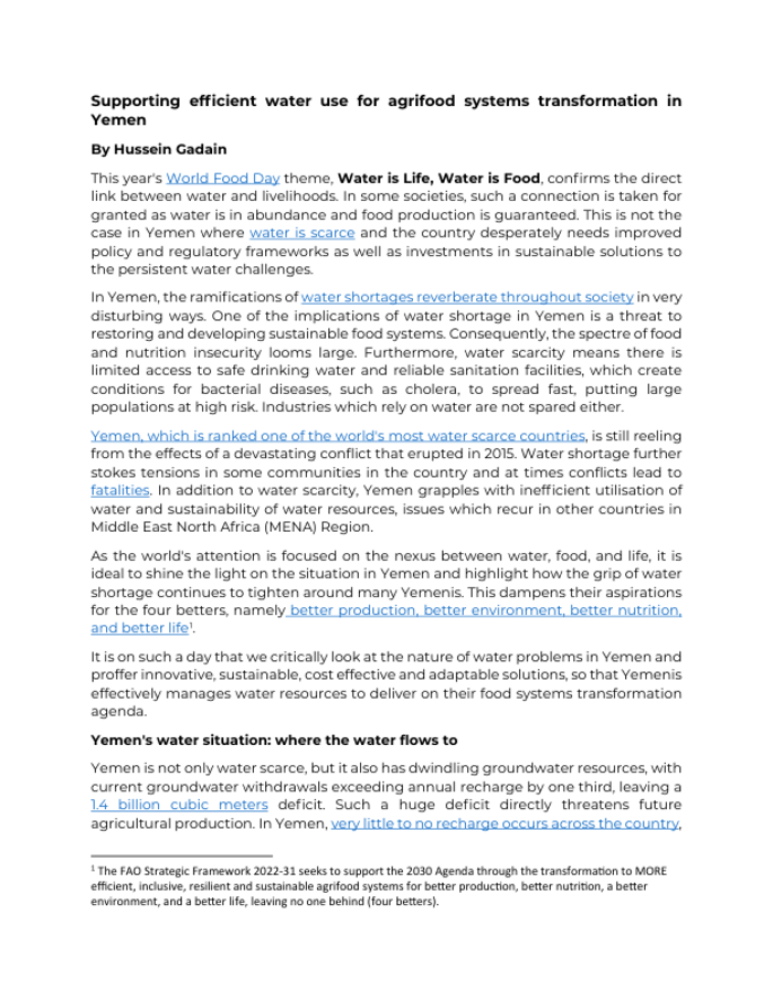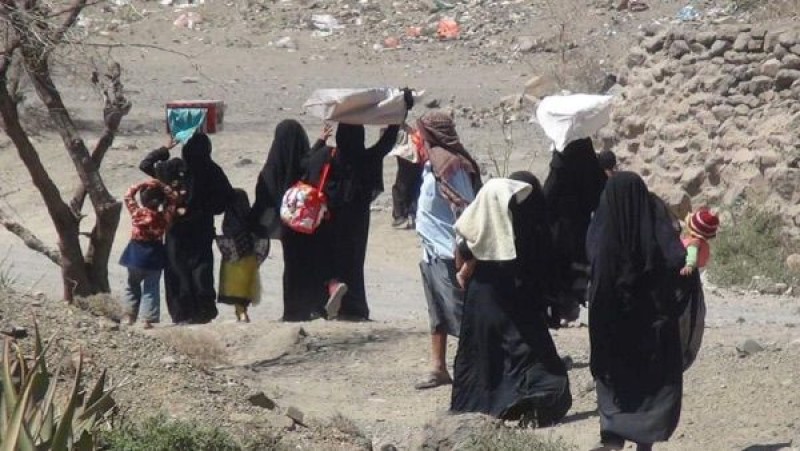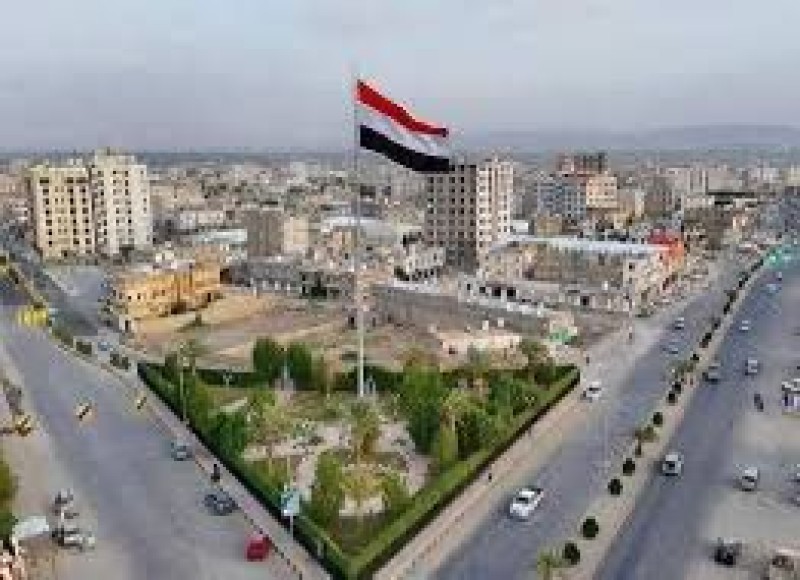Supporting efficient water use for agrifood systems transformation in Yemen


This year's World Food Day theme, Water is Life, Water is Food, confirms the direct link between water and livelihoods. In some societies, such a connection is taken for granted as water is in abundance and food production is guaranteed. This is not the case in Yemen where water is scarce and the country desperately needs improved policy and regulatory frameworks as well as investments in sustainable solutions to the persistent water challenges.
In Yemen, the ramifications of water shortages reverberate throughout society in very disturbing ways. One of the implications of water shortage in Yemen is a threat to restoring and developing sustainable food systems. Consequently, the spectre of food and nutrition insecurity looms large. Furthermore, water scarcity means there is limited access to safe drinking water and reliable sanitation facilities, which create conditions for bacterial diseases, such as cholera, to spread fast, putting large populations at high risk. Industries which rely on water are not spared either.
Yemen, which is ranked one of the world's most water scarce countries, is still reeling from the effects of a devastating conflict that erupted in 2015. Water shortage further stokes tensions in some communities in the country and at times conflicts lead to fatalities. In addition to water scarcity, Yemen grapples with inefficient utilisation of water and sustainability of water resources, issues which recur in other countries in Middle East North Africa (MENA) Region.
As the world's attention is focused on the nexus between water, food, and life, it is ideal to shine the light on the situation in Yemen and highlight how the grip of water shortage continues to tighten around many Yemenis. This dampens their aspirations for the four betters, namely better production, better environment, better nutrition, and better life .
It is on such a day that we critically look at the nature of water problems in Yemen and proffer innovative, sustainable, cost effective and adaptable solutions, so that Yemenis effectively manages water resources to deliver on their food systems transformation agenda.
Yemen's water situation: where the water flows to
Yemen is not only water scarce, but it also has dwindling groundwater resources, with current groundwater withdrawals exceeding annual recharge by one third, leaving a 1.4 billion cubic meters deficit. Such a huge deficit directly threatens future agricultural production. In Yemen, very little to no recharge occurs across the country, and this can be achieved through artificial groundwater recharge for example by increasing the amount of water that enters aquifers by redirecting water through canals. Recharge helps to counterbalance the depletion of groundwater, thereby mitigating the adverse effects of climate change.
In Yemen, agricultural production accounts for 90 percent of water withdrawal, against a global average of 70 percent. A huge portion, around 30 percent, of these massive water withdrawals goes to Qat production. Qat growing is water intensive. The high water consumption of the plant increases physical water scarcity by reducing the available surface and groundwater sources.
The future also looks bleak.
Yemen's agriculture sector heavily relies on rainfall, much of it is received in the highlands and coastal areas with inland areas remaining arid. Most of the rains are received within short periods and most of it is lost. A recent study suggested that future rainfall in Yemen is likely to be less effective for agricultural production. Yemen is highly vulnerable to climate-change-driven extreme events which makes the country one of the most food insecure in the MENA region and globally.
Unclasping the grip of water shortage induced food insecurity.
A session on The State of Food and Agriculture: Integrated Water Resources Management during this year’s FAO Conference, in July, confirmed that the global water system is at a breaking point. This session further acknowledged that transforming agrifood systems to achieve the Sustainable Development Goals (SDGs) sustainably will require integrated water resources management (IWRM), and efficient water use in both irrigated and rain fed agriculture. FAO was also requested, during this session, to further develop programmatic initiatives on flood and disaster risk management.
Such a global acknowledgement of the central role of water availability in transforming agrifood systems means that all is not lost in the country as the tide can be turned. Current and previous interventions carried out by FAO have shown that the situation can be saved.
FAO’s interventions in Yemen are guided by this global thrust, but tailor made for the local context. These interventions are designed to support IWRM into national sustainable development strategies, policies and cross-sectoral investment plans. The goal is to meet the growing need for food production and ensure equitable access to food while curtailing and reversing environmental degradation and climate change impacts.
This entails implementing practical solutions to address challenges of increasingly limited quantity and inferior quality of water for food production. These interventions help FAO in Yemen deliver on the four betters.
Increasing agricultural water productivity through more efficient irrigation systems and better agricultural management practices is key for improving water use efficiency in Yemen. However, investment in water efficient technologies has been sparse in Yemen. A few funding partners have come to the table. The few interventions which have been implemented by FAO have shown encouraging results.
Tapping into FAO’s expertise for sustainable solutions to water scarcity in Yemen
An integrated water resources management approach project FAO piloted in the Sana’a Basin saw a reduction of water used on irrigated land by 19 percent; from 72.6 cubic metres per hectare a year to 58.56 cubic metres a hectare per year. This was achieved through adoption of modern irrigation equipment, piped conveyance systems, protected agriculture (greenhouses), recharge of underground aquifers, planting perennial tree crops (almonds and peaches), and use of rehabilitated water harvesting infrastructure.
The successful implementation of the water conserving interventions in the Sana’a basin has been replicated in Wadi Hajr where irrigation infrastructure damaged by recent flooding has been rehabilitated. Additionally, FAO is strengthening community watershed governance and promoting ecological and restorative agriculture, for example growing wheat, throughout the watershed. This enhances food security and income earning opportunities for the farming communities in the wadi, including women and youth in the area.
Similarly, building on the success of previous interventions, FAO implemented a water for peace project in wadi Hadramout helped to mitigate water-based with the inclusion of women as conflict-resolution agents. Through cash for work, participating communities protected wadi banks and rehabilitated irrigation canals. Farming communities (men, women and youth) were engaged, under the project, to resolve local conflicts over upstream and downstream water allocation. In addition, the project introduced drought-tolerant crops as a climate change mitigation measure.
Another intervention is enhancing water governance, food security, and reconciliation in conflict-affected communities in Abyan, Dhamar, and Hadramout. This is being done through improving agricultural production and water management, reducing water-related conflicts and disaster risks. Water infrastructure is being rehabilitated to improve access to irrigation water and increase irrigation water efficiency through modern systems. This ensures that water loss is minimised and the little that is available is put to good use.
In all the above mentioned interventions, FAO is encouraging local level water management. In the true spirit of leaving no one behind, FAO is ensuring the involvement of women in local level management. To address conflicts over water resources and efficiently use available resources, FAO has enhanced institutional development by educating and training farmers by establishing Water User Associations (WUAs). WUAs use a participatory approach and have been critical in resolving conflict over water resources. The participation of women in these WUAs has been instrumental in resolving conflicts.
FAO is promoting the growing of less water intensive cash crops. This dampens the appetite for growing qat which consumes a lot of water. In Yemen, FAO is helping to modernise plans for irrigation schemes to make rain-fed agriculture more resilient and productive, as well as technical work to support sound water policies and investments in infrastructure and research.
More ground is still to be covered though.
While we bemoan the limited investment in sustainable and efficient water management technologies, there are policy and regulatory issues which need urgent address before it is too late. For example, Yemen, together with other NENA countries, have weak policy directions as well as science-policy interface regarding water use. The legal frameworks are also challenged by lack of enforcement capacity.
It is equally important for the regulatory authorities to critically examine the efficacy of some of the technologies which have been adopted to ease the water problem. For example, the proliferation of solar energy for driving water pumps, has proven very useful, but it could lead to disastrous and irreversible effects in the long term.
Conclusion
As we mark World Food Day, we should spare a thought for Yemenis. It looks bleak for them as the water situation remains untenable and is further deteriorating. However, the solutions are there, and they have been shown to work. What is needed is to join hands and make sure that what has yielded positive results so far is further scaled up and save the situation.
More investment into efficient water management systems will be a huge step towards ensuring better production, better environment, better nutrition, and better life for Yemenis. In addition to investment, it is important to enhance the role of community groups, including women, to improve water resources management. It is also vital to improve the policy and regulatory frameworks to ensure lasting solutions to perennial water problems. FAO is there to help as it has expertise in these areas.
Together, we can take water action for food and be the change. Happy World Food Day 2023.

Aden — The International Organization for Migration (IOM) reported that more than 24,000 people have been internally displaced in Yemen since…

MARIB — Security sources reported that police in Marib governorate have opened investigations into two separate suicide incidents that occurr…

Hodeidah — Two members of the Iranian-backed Houthi militia were killed and five others wounded in a landmine explosion near Hodeidah airport…